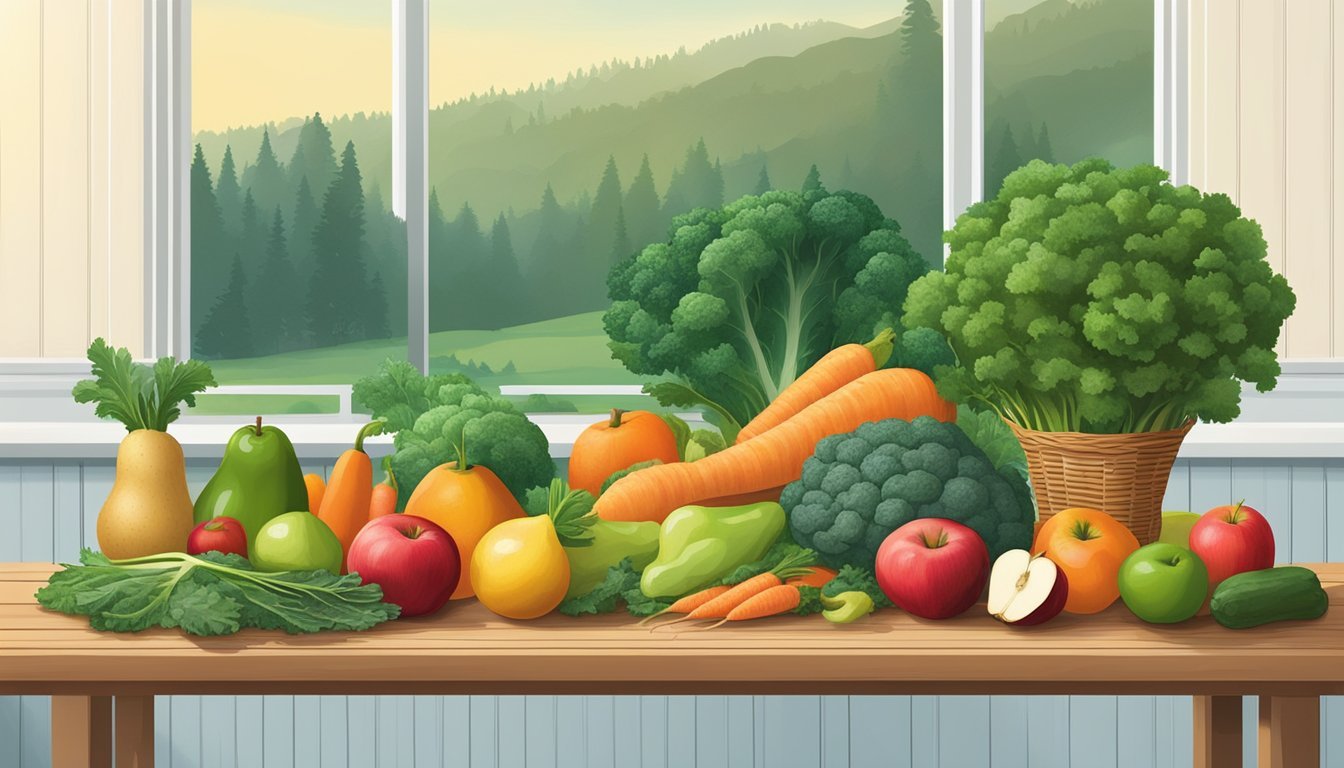Oregon Seasonal Fruit & Vegetables in March
A Guide to Fresh Produce Selection
This Article is Part of our Oregon Seasonal Fruit & Veg Calendar
March in Oregon signals a period of transition where the leaner winter months give way to the promise of spring's bounty. While the variety of seasonal produce available during this month might not be as vibrant as it is during the peak summer months, there are still plenty of fresh fruit (What wine goes well with fruit?) and vegetables that can be sourced from local farms and markets. Oregon's climate and fertile soil allow for some vegetables to be grown and harvested early in the year.
Root vegetables and hearty greens, which are capable of withstanding the cooler temperatures of the Pacific Northwest's early spring, are among March's seasonal offerings. These earthy staples are often the last of the winter harvest or the first of the year’s new growth. Items such as cabbage and Brussels sprouts (how long do brussels sprouts last?)may still be available from winter plantings, while preparations for planting early spring crops like peas and leafy greens begin as the soil thaws.
Oregon's seasonal palette in March might not feature the berries and stone fruits that define its summer produce; however, it is a crucial time for Oregon farmers who are preparing for the abundance of the coming seasons. March’s selection is a reminder of the resilience of winter crops and the imminent arrival of spring’s diverse produce.
Understanding Oregon's Growing Season
Oregon's diverse climate and geography dictate its growing season, with March marking a transitional period between winter and spring. This month is pivotal for understanding what produce is coming into season.
Climate and Geography
Oregon's climate varies from coastal regions to interior valleys and high desert in the east, influencing the length and timing of its growing season. Coastal areas benefit from milder weather, while the Cascade Range creates rain shadows, leading to drier conditions eastward. In March, Oregon is emerging from winter, with temperatures rising but still capable of frost.
Month-by-Month Crop Availability
By March, the Oregon growing season is on the cusp of spring. Cool-season crops are in focus, and with the soil beginning to warm, certain crops become available. Here is a selection of Oregon's crops available in March:
Vegetables:
Arugula
Cabbage
Fruits:
Storage apples (from previous harvests)
It is important to note that specific crop availability can vary based on regional climate variations within Oregon.
March Bounty in Oregon
As March ushers in the first whispers of spring in Oregon, local farms begin to harvest a fresh array of produce. This month, the focus is on the early fruits and vegetables that thrive in the state's climate.
Fruit Highlights
Oregon's March fruit offerings are sparse as the season is just beginning. While the full bounty of spring and summer fruits is yet to come, there are still some harvests to take note of:
Rhubarb: Technically a vegetable, but often used as a fruit in culinary contexts, rhubarb starts to make its appearance.
Vegetable Highlights
The cool, damp springs of Oregon are conducive to the growth of a variety of hardy vegetables. Here are some of the highlights from local farms:
Leafy Greens: Start looking for tender new lettuces and spinach.
Cole Crops: Cruciferous vegetables like cabbages, cauliflowers, broccoli (how long does broccoli last?), and Brussels sprouts are seeded indoors to prepare for later transplanting.
Root Vegetables: Hardy options like radishes, carrots (how long do carrots last?), and beets are sown in Oregon soils.
Alliums: Onions and leeks are typically ready to be planted outdoors in March.
Peas: Both snow peas and shelling peas are a cool-season favorite that can be started this time of year.
Herbs: Parsley and chives (how long do chives last?) can be planted now, providing a fresh, aromatic addition to meals.
Seasonal Recipes and Preparation
March in Oregon brings a variety of fresh produce options suitable for an array of recipes. Utilizing these ingredients in their peak season promises vibrant flavors and optimal nutrition.
Vegetable-Based Dishes
Broccoli, cabbage, and carrots are hearty vegetables that can be enjoyed in several ways. For a warming meal, they might consider a Slow Cooker Italian Vegetable Beef Soup, where the broccoli and carrots can be added raw, simmering until tender. Another idea is to make a fresh cabbage salad, sliced thinly and dressed with a light vinaigrette.
Recipe: Roasted Carrot & Broccoli Dish
Ingredients: Fresh carrots, broccoli florets, olive oil, salt, pepper, and minced onion.
Directions:
Preheat oven to 400°F (200°C).
Toss carrots and broccoli with olive oil, minced onion, salt, and pepper.
Spread on a baking sheet and roast for 20-25 minutes until caramelized.
For those enjoying plant-based diets or Meatless Mondays, spinach can be incorporated into a delicious raw salad or sautéed as a side.
Fruit-Based Treats
By March, the selection of fruits such as apples that have been stored from fall harvests are still available, while early rhubarb begins to make an appearance. These fruits lend themselves to sweet and tangy desserts.
Recipe: Baked Apple & Rhubarb Crumble
Ingredients: Sliced apples, diced rhubarb, flour, brown sugar, oats (how long do oats last?), butter, and cinnamon.
Directions:
Preheat the oven to 375°F (190°C).
Mix apples and rhubarb with a portion of brown sugar and cinnamon; place in a baking dish.
Combine flour, oats, remaining sugar, and butter to form a crumble topping. Sprinkle over the fruit.
Bake for 30-35 minutes until golden and bubbling.
For those preferring raw, fresh treats, they could slice strawberries—if available—as a topping for morning oatmeal or blend them into smoothies for a refreshing beverage.
Sustainable Agricultural Practices
In Oregon, sustainable agricultural practices reflect a deep understanding of the local ecology and a commitment to preserving it. Farmers across the state emphasize methods that contribute positively to the environment and the local community.
Organic Farming
Organic farming stands as a cornerstone of sustainable agriculture in Oregon. This method privileges the use of natural processes and materials, eschewing synthetic fertilizers and pesticides. Farmers maintain soil health through crop rotation, composting, and the use of green manures. Certified organic farms limit their ecological impact and bolster soil fertility, which is essential for producing a range of seasonal fruits and vegetables.
Local Farms and Community Support
Local Farms in Oregon foster community support through direct farm-to-consumer sales avenues, such as farmers' markets and community-supported agriculture (CSA) programs. These small-scale farms often employ sustainable practices, including water conservation and minimal reliance on fossil fuels. Community support for these farms sustains local economies and reduces carbon footprints associated with long-distance food transportation.
Where to Find Seasonal Produce
In March, purchasing seasonal produce in Oregon directly supports local farmers and ensures that consumers receive fresh and flavorful fruits and vegetables. There are two primary venues where one may find an array of seasonal items: farmers' markets and local grocery stores.
Farmers' Markets
Farmers' markets are the ideal destination for consumers seeking farm-fresh produce. In March, visitors to these markets will discover a variety of in-season vegetables such as beets (how long do beets last?), broccoli, and Brussels sprouts. These markets typically feature farmers who offer their latest harvests, which may include the tail end of winter produce and the earliest spring offerings. By shopping at farmers' markets, consumers can engage directly with growers to learn more about the seasonal fruits and vegetables available.
Typical in-season produce one might find at Oregon farmers' markets in March includes:
Vegetables: Beets, Broccoli, Brussels Sprouts
Fruits: In later March, early varieties of rhubarb may begin to appear
Local Grocery Stores
Local grocery stores are another convenient source for seasonal produce, especially for those who may not have access to farmers' markets. These stores typically source from local farms when possible, providing a selection of in-season fruits and vegetables. Grocery stores offer the advantage of consistent operating hours and locations, making them a reliable option for seasonal shopping throughout the year.
Seasonal produce to look for in Oregon grocery stores during March:
Vegetables: Beets, Broccoli, Brussels Sprouts
Fruits: Look for the early arrival of rhubarb, signaling the start of spring
By choosing to shop for in-season produce at either farmers' markets or local grocery stores, consumers not only enjoy fresh and flavorful foods but also contribute to the sustainability of Oregon's agricultural economy.
Seasonal Eating and Nutrition
In March, the variety of fresh produce available in Oregon shifts, providing a range of nutritional benefits. Eating seasonally aligns with the natural growing cycles and tends to ensure higher nutritional value.
Health Benefits of Seasonal Eating
Seasonal produce tends to be fresher and, as a result, boasts a higher nutrient profile compared to fruits and vegetables that are available year-round but may have been stored for long periods or shipped from far away. For instance, in March, Oregonians can benefit from the nutritional value found in stored apples and pears, which are rich in fibers and vitamins.
Certain vegetables like asparagus, which begins its season in March, offer a fresh option for spring diets and bring with them a host of vitamins such as A, C, E, and K. These nutrients play crucial roles in the body, ranging from supporting immune function to maintaining healthy skin and vision.
Incorporating Seasonal Produce into Your Diet
To incorporate these nutritious fruits and vegetables into one's diet, one can consider simple preparations like a salad to enjoy the crisp textures and flavors. For example, an Oregon March salad might include mixed greens, slices of apple or pear, and a sprinkle of local hazelnuts for added crunch.
Another way to enjoy seasonal produce is by planting a garden with suitable March starters such as cauliflower seeds, which can later be harvested and served at peak freshness. Starting a garden not only provides access to nutritious vegetables but also ensures that they are as fresh as possible.
By focusing on seasonal eating, one benefits from the higher nutritional value of produce and contributes to a sustainable food economy.






